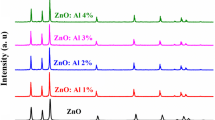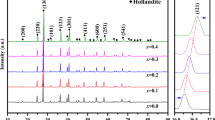Abstract
With aluminum as the predominant element, incineration residues from municipal solid waste and sewage sludge may be reused as precursors for zinc stabilization. As solid-state reactions are influenced by the crystal sizes of the reactants, the aluminum-containing components with different crystal sizes in the incineration residues may affect zinc transformation and immobilization. In this study, Al2O3 was prepared with a variety of crystal sizes to simulate the aluminum-rich incineration residue matrix, and ZnO was mixed with Al2O3 to study the zinc incorporation mechanisms. The crystal sizes of Al2O3 were determined using Rietveld refinement. Quantification results showed that ~ 30% of zinc was incorporated into the ZnAl2O4 spinel when Al2O3 with the largest crystal size was used. However, the zinc transformation was enhanced twofold when the Al2O3 precursor had the smallest crystal size. This study confirmed the potential enhancement of zinc immobilization by nanoscale crystals in simulated aluminum-rich incineration residues. By improving zinc stabilization efficiencies using poorly crystallized aluminum-containing compounds instead of increasing the energy consumption by increasing the sintering temperatures, we can achieve an economic and environmental win–win scenario for the beneficial utilization of incineration residues of municipal solid waste and sewage sludge.





Similar content being viewed by others
References
Chong AMY, Wong YS, Tam NFY (2000) Performance of different microalgal species in removing nickel and zinc from industrial wastewater. Chemosphere 41:251–257
Katsou E, Malamis S, Haralambous KJ (2011) Industrial wastewater pre-treatment for heavy metal reduction by employing a sorbent-assisted ultrafiltration system. Chemosphere 82:557–564
Monser L, Adhoum N (2002) Modified activated carbon for the removal of copper, zinc, chromium and cyanide from wastewater. Sep Purif Technol 26:137–146
Barceloux DG (1999) Zinc. J Toxicol Clin Toxicol 37(2):279–292
Mulligan CN, Yong RN, Gibbs BF (2001) Remediation technologies for metal-contaminated soils and groundwater: an evaluation. Eng Geol 60:193–207
Shih K, White T, Leckie JO (2006) Nickel stabilization efficiency of aluminate and ferrite spinels and their leaching behavior. Environ Sci Technol 40:5520–5526
Tang Y, Chui SS-Y, Shih K, Zhang L (2011) Copper stabilization via spinel formation during the sintering of simulated copper-laden sludge with aluminum-rich ceramic precursors. Environ Sci Technol 45:98–3604
Tang Y, Shih K, Wang Y, Chong T-C (2011) Zinc stabilization efficiency of aluminate spinel structure and its leaching behavior. Environ Sci Technol 45:10544–10550
Ndiba PK, Axe L (2009) Sequential extraction of phosphate-and thermal-treated New York/New Jersey Harbor dredged sediments. Environ Eng Sci 26:1755–1764
Meer I, Nazir R (2017) Removal techniques for heavy metals from fly ash. J Mater Cycles Waste Manag 10:1–20
Takaoka M, Takeda N, Miura S (1997) The behaviour of heavy metals and phosphorus in an ash melting process. Water Sci Technol 36:275–282
Cyr M, Idir R, Escadeillas G (2012) Use of metakaolin to stabilize sewage sludge ash and municipal solid waste incineration fly ash in cement-based materials. J Hazard Mater 243:193–203
Margallo M, Taddei MBM, Hernández-Pellón A, Aldaco R, Irabien Á (2015) Environmental sustainability assessment of the management of municipal solid waste incineration residues: a review of the current situation. Clean Technol Environ Policy 17:1333–1353
Krüger O, Grabner A, Adam C (2014) Complete survey of German sewage sludge ash. Environ Sci Technol 48:11811–11818
Mian MM, Zeng X, Nasry ANB, Al-Hamadani SMZF (2017) Municipal solid waste management in China: a comparative analysis. J Mater Cycles Waste Manag 19:1127–1135
Xiao Z, Yuan X, Li H, Jiang L, Leng L, Chen X, Zeng G, Li F, Cao L (2015) Chemical speciation, mobility and phyto-accessibility of heavy metals in fly ash and slag from combustion of pelletized municipal sewage sludge. Sci Total Environ 536:774–783
Krüger O, Adam C (2015) Recovery potential of German sewage sludge ash. Waste Manag 45:400–406
Donatello S, Cheeseman CR (2013) Recycling and recovery routes for incinerated sewage sludge ash (ISSA): a review. Waste Manag 33:2328–2340
Merino I, Arévalo LF, Romero F (2007) Preparation and characterization of ceramic products by thermal treatment of sewage sludge ashes mixed with different additives. Waste Manag 27:1829–1844
Donatello S, Tyrer M, Cheeseman CR (2010) EU landfill waste acceptance criteria and EU Hazardous Waste Directive compliance testing of incinerated sewage sludge ash. Waste Manag 30:63–71
Liu D, Zhang B, Liu X, Li J (2015) Cyclohexane oxidation over AFI molecular sieves: effects of Cr, Co incorporation and crystal size. Catal Sci Technol 5:3394–3402
Petushkov A, Intra J, Graham JB, Larsen SC, Salem AK (2009) Effect of crystal size and surface functionalization on the cytotoxicity of silicalite-1 nanoparticles. Chem Res Toxicol 22:1359–1368
Ottosen LM, Kirkelund GM, Jensen PE (2013) Extracting phosphorous from incinerated sewage sludge ash rich in iron or aluminum. Chemosphere 91:963–969
Young RA (1995) The Rietveld method, Oxford University Press
Vippola M, Valkonen M, Sarlin E, Honkanen M, Huttunen H (2016) Insight to nanoparticle size analysis—novel and convenient image analysis method versus conventional techniques. Nanoscale Res Lett 11:169
Penn RL, Soltis JA (2014) Characterizing crystal growth by oriented aggregation. CrystEngComm 16:1409–1418
Gogebakan M, Kursun C, Eckert J (2013) Formation of new Cu-based nanocrystalline powders by mechanical alloying technique. Powder Technol 247:172–177
Trejo F, Ancheyta J, Morgan TJ, Herod AA, Kandiyoti R (2007) Characterization of asphaltenes from hydrotreated products by SEC, LDMS, MALDI, NMR, and XRD. Energ Fuel 21:2121–2128
Uvarov V, Popov I (2013) Metrological characterization of X-ray diffraction methods at different acquisition geometries for determination of crystallite size in nano-scale materials. Mater Charact 85:111–123
Zhang Z, Zhou F, Lavernia EJ (2003) On the analysis of grain size in bulk nanocrystalline materials via X-ray diffraction. Metall Mater Trans A 34:1349–1355
Kim HS, Park N-K, Lee TJ, Kang M (2014) Effect of AlF3 seed concentrations and calcination temperatures on the crystal growth of hexagonally shaped α-alumina powders. Ceram Int 40:3813–3818
Wang W, Fu Z, Wang H, Yuan R (2002) Influence of hot pressing sintering temperature and time on microstructure and mechanical properties of TiB2 ceramics. J Eur Ceram Soc 22:1045–1049
Zhou W, Wang J, Wang Z, Zhang Q, Guo C, Li J, Guo Y (2017) Size effects of shear deformation response for nano-single crystals examined by the phase-field-crystal model. Comput Mater Sci 127:121–127
Bauer EB, Hampel F, Gladysz JA (2003) Alkene metatheses in transition metal coordination spheres: Effect of ring size and substitution on the efficiencies of macrocyclizations that join trans positions of square-planar platinum complexes. Organometallics 22:5567–5580
Park J-Y, Lee Y-J, Karandikar PR, Jun K-W, Ha K-S, Park H-G (2012) Fischer–Tropsch catalysts deposited with size-controlled Co3O4 nanocrystals: effect of Co particle size on catalytic activity and stability. Appl Catal A-Gen 411:15–23
Walenta G, Füllmann T (2004) Advances in quantitative XRD analysis for clinker, cements, and cementitious additions. Powder Diffr 19:40–44
Chen D, Moljord K, Fuglerud T, Holmen A (1999) The effect of crystal size of SAPO-34 on the selectivity and deactivation of the MTO reaction. Micropor Mesopor Mat 29:191–203
Wilkenhöner U, Langhendries G, Laar FV, Baron GV, Gammon DW, Jacobs PA, Steen EV (2001) Influence of pore and crystal size of crystalline titanosilicates on phenol hydroxylation in different solvents. J Catal 203:201–212
Acknowledgements
This work was supported financially by the National Natural Science Foundation of China (NSFC) (21707063), Shenzhen Science and Technology Innovation Committee (JCYJ20150601155130432; JCYJ20160429191618506), and Hong Kong Research Grants Council (17212015).
Author information
Authors and Affiliations
Corresponding author
Rights and permissions
About this article
Cite this article
Tang, Y., Xin, X., Shih, K. et al. Effect of crystal size on zinc stabilization in aluminum-rich ceramic matrix. J Mater Cycles Waste Manag 20, 2110–2116 (2018). https://doi.org/10.1007/s10163-018-0765-y
Received:
Accepted:
Published:
Issue Date:
DOI: https://doi.org/10.1007/s10163-018-0765-y




